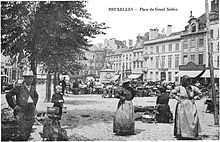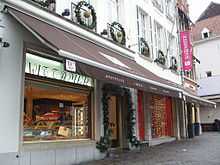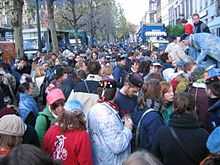Sablon (Brussels)
The Sablon (French) or Zavel (Dutch) is a neighbourhood and hill in the historic upper town of Brussels. At its heart are the twin squares of the larger Grand Sablon (French for Large Sablon) or Grote Zavel square in the northwest and the smaller Petit Sablon (French for Small Sablon) or Kleine Zavel square and garden in the southeast, divided by the Church of Our Blessed Lady of the Sablon.
History

Early history
The Sablon lies near the Mont des Arts district, and lay not far outside the first city walls of Brussels. It was originally an unused open space, with areas of wetlands, grassland and sand, where a hermit made his home. The words sablon and zavel both mean a fine-grained sand, halfway between silt and sand.[1] The Saint John Hospital (Dutch: Sint-Jansgasthuis, French: Hôpital Saint-Jean) used the area as a cemetery in the thirteenth century, having run out of space in their own cemetery.[2]
In 1304, the hospital sold the land to the crossbowmen's guild. They built a small chapel on the site dedicated to Our Lady, completed in 1318, setting off the transformation of the area.[2] The chapel became renowned and began to draw pilgrims and the pious when, in 1348, a woman brought to the chapel a miraculous statue of the Virgin Mary that had been stolen from Antwerp. The statue of Mary was then solemnly placed in the chapel and venerated as the patron of the guild. The guild also promised to hold an annual procession, called an Ommegang, in which the statue was carried through Brussels. This Ommegang of Brussels developed into an important religious and civil event in the calendar of Brussels.[1]
15th to 18th centuries
In the fifteenth century, the district began to enlarge substantially. The chapel was rebuilt as the larger and more elegant Church of Our Blessed Lady of the Sablon, still standing today. In 1470, Duke Charles the Bold charged a body with the creation of a street running from his nearby Coudenberg Palace to the church. The church became the site of the baptisms of princes; Archduchess Mary of Austria's baptismal cortège went to Our Blessed Lady of the Sablon instead of the Church of St. Michael and St. Gudula, which had previously held the honour. Governor Margaret of Austria made it the site of her religious devotions as well. In 1530, it saw the greatest July procession in its history. These symbols of royal favour would ensure the lasting prosperity of the Sablon area. The Wolweide (Dutch: Wool District) area, corresponding loosely to the current rue aux Laines/Wolstraat, was an extension of the Sablon, stretching to the slopes of the Galgenberg, where the modern Palace of Justice now sits.

In the sixteenth century, the most prominent noblemen established themselves on the upper Sablon and on rue aux Laines. The Egmonts, the Culemborgs, the Brederodes and the Mansfelds were the first, and the De Lannoys, the De Lalaings, the Thurn und Taxis, and the Solres joined them. The result was that by the seventeenth century, the Sablon area had grown to become the most aristocratic and prosperous area in the city. The Egmont Palace on the Petit Sablon is still standing, and gives the best indication of what the area was like at the height of its splendour; the grandiose houses of the Lannoys and the Mérode-Westerloo family still stand in rue aux Laines. In 1566 the Culemborg mansion on rue des Petits Carmes/Karmelietenstraat was the site of the drafting of the Compromise of Nobles which ultimately led to the Dutch Revolt.[3] To eliminate any trace of this seditious act against the king, the Duke of Alba razed the mansion to the ground in 1568.[3]
The proximity of the cemetery was already an irritation to its aristocratic neighbours in 1554, but it would be another century and a half before the government of Brussels recognized that the situation had become unbearable. They reported that corpses "were often neglected and left in only half-covered graves, from which dogs had several times pulled parts off and run around in broad daylight with arms and legs in their mouths".[4] It was therefore decided in 1704 to move the cemetery to the Marolles district.[1]

19th century to present
The Sablon district was remodelled in the nineteenth century as rue de la Régence/Regentschapstraat was driven through the area, creating a Haussmann-style artery between the Royal Palace of Brussels and the new Palace of Justice. The new street skirted the church: all buildings immediately adjacent to it were demolished starting in 1872, opening up new views of the church. Buildings not directly adjacent to the church were renovated and improved.[5]
From the 19th to early 20th centuries, the The Grand Sablon became a renowned site for a sport called balle pelote , a sort of handball. Though the sport is no longer played much today, it enjoyed immense popularity at the time. The Kings of the Belgians would frequently be seen among the spectators of a match; Leopold II explained that he would frequently come watch the games, as he lived in the area.[6]
The social composition of the neighbourhood changed over the course of time. In the 19th century, it was incrementally abandoned by the aristocracy in favour of newer, more chic neighbourhoods, such as the Leopold Quarter. In the 20th century, the Grand Sablon square was occupied by a more modest populace, characterized by small workshops and warehouses. At the end of the 1960s, the character of the area began to change yet again. Multiple antique stores moved to the area, following demolitions in the nearby Mont des Arts area.[7] Bit by bit the Sablon became a desirable area once again, giving rise to the neologism "sablonisation", a local version of gentrification. Recently, a number of chocolatiers and confectioners have come to the area.[1] The area is once again the heart of the Brussels upper class.[8]
Grand Sablon

History
The Grand Sablon square lies to the northwest of the church. It is in the shape of a long triangle, around 50m wide in the southeast, terminating in a point around 130m to the northwest. When Brussels residents refer to the 'Sablon' without qualification, they are usually referring to the Grand Sablon.[9] The Grand Sablon was linked to the Petit Sablon by rue Bodenbroek/Bodenbroekstraat and rue des Sablons/Zavelstraat, though the division between the two Sablons was accentuated by rue de la Régence cutting through the area.[1]
In the 16th century, the Grand Sablon was known as the Peerdemerct (Middle Dutch for Horse Market, Latin: Forum Equorum), due to the horse market that was held there from 1320 to 1754. The place was also known as the Zavelpoel (Sandy pond)[10] due to a pond in the centre which would last until 1615. After the pond was filled in, a fountain was erected in its place in 1661. Water was brought to the fountain by a new conduit from Obbrussel (now Saint-Gilles). This fountain was replaced in 1754 by the present Fountain of Minerva , which was a posthumous gift from the exiled British nobleman Thomas Bruce, 2nd Earl of Ailesbury, who wished to thank the people of Brussels for their hospitality. The fountain was renovated in 1999.[11]
The Grand Sablon was often the stage for festivals and competitions, but also for tragic events. On June 1, 1568, it was the site of a mass execution, as 18 signatories of the Compromise of Nobles were decapitated.[12]

Present day
The Grand Sablon is nowadays a genuine neighbourhood with residents and small businesses, while at the same time being a popular place to stroll and a tourist attraction. Surrounding the square are numerous antique stores, fashionable boutiques, hotels, restaurants, an auction house, and numerous pastry shops and well-known Belgian chocolatiers, including Neuhaus, Pierre Marcolini and Godiva. On Saturdays and Sundays the Grand Sablon hosts the Sablon Antiques and Books Market.[1]
As is the case with many other public squares in Brussels, the Grand Sablon has been partially transformed into a parking lot. A plan to refurbish the space is being investigated.
Each year, the Sablon is the starting point for the Ommegang of Brussels procession. On November 20, it hosts the beginning of the Saint-Verhaegen student parade, which celebrates the founding of the Université libre de Bruxelles and the Vrije Universiteit Brussel universities.[13]
Petit Sablon
To the southeast of the church, and slightly uphill, lies the Petit Sablon square. It is a roughly rectangular garden, featuring trees, hedges, flowers and most notably, statues.
In the Middle Ages, the Zavelbeek (Sablon Brook) had its source in the Petit Sablon. It flowed in nearly a straight line into the Senne river, joining it roughly at the modern place Fontainas/Fontainasplaats. Its course is still followed by the streets in the area to this day.[14] The Petit Sablon was the site of the Saint John Hospital's cemetery, mentioned above, until it was moved.[1]
The present-day garden was created by the architect Henri Beyaert, and was inaugurated in 1890. It is surrounded by an ornate wrought iron fence inspired by one which once decorated the Coudenberg Palace. The fence is punctuated by tall stone pillars; atop each pillar is a statue of one or more historical professions, with 48 statues in total. To ensure that the statues were stylistically coherent, Beyart asked painter Xavier Mellery to design all of the statues. Each pillar has a unique design, as does each section of fence.[15]
-
The Tiler
-
The Clockmaker-Locksmith
-
The Tinsmith-Plumber
In the centre of the garden lies a fountain of Counts Edgmont and Horne, who were symbols of resistance against the Spanish tyranny that sparked the Dutch Revolt. The fountain was initially in front of the Maison du Roi/Broodhuis on the Grand Place, the site of their execution. The fountain is surrounded by a semicircle of ten statues of political figures, intellectuals and artists from the 16th century.[16]
References
- ↑ 1.0 1.1 1.2 1.3 1.4 1.5 1.6 "Le Sablon" (in French). City of Brussels. Retrieved April 20, 2014.
- ↑ 2.0 2.1 (French) Le Sablon. Le quartier et l'église, Ville d'Art et d'Histoire. n° 9, Editions Solibel & Brussels-Capital Region, 1995, p. 3
- ↑ 3.0 3.1 Monica Stensland (2012). Habsburg Communication in the Dutch Revolt. Amsterdam University Press. ISBN 9789089644138.
- ↑ (French) « ...estoient souvent négligés et mis dans les fosses à moitié couverts, dont les chiens avoient plusieurs fois tiré des pièces et couru en plein jour avec les bras et les jambes... » Alexandre Henne and Alphonse Wauters, Histoire de la ville de Bruxelles, Éditions Libro-Sciences, 1968, Tome 3, p. 401
- ↑ (French) Le Patrimoine monumental de la Belgique: Bruxelles, Volume 1C, Pentagone N-Z, Pierre Mardaga éditeur, 1994, p. 274
- ↑ (French) Jacques Dubreucq, Bruxelles 1000. Une histoire capitale, Edited by the author, 1996, Volume 1, p. 258
- ↑ (French) Itinéraire de la rénovation des quartiers anciens à Bruxelles : 8 km à pied à travers le Pentagone et Molenbeek , Collection Hommes et Paysages, Société Royale Belge de Géographie, 2001, p. 63
- ↑ "De week van tvbrussel vanuit het Museum van de Stad Brussel" (in Dutch). TV Brussel. 23 August 2014. Retrieved 18 September 2014.
- ↑ (French) Jean d'Osta, Dictionnaire historique et anecdotique des rues de Bruxelles, Le Livre, 1995, p. 293
- ↑ (French) Roel Jacobs, Bruxelles, l'histoire de la ville, Éditions Marc van de Wiele, 1994, p. 78
- ↑ (French) La fontaine de Minerve coule à nouveau, Le Soir, 4 December 1999
- ↑ (French) Louis Verniers, Un millénaire d'histoire de Bruxelles. Des origines à 1830, Éditions A. De Boeck, 1965, p. 227
- ↑ "Saint-Verhaegen calme et fraîche: moins d'interventions qu'en 2012" (in French). RTBF. November 20, 2013. Retrieved April 24, 2013.
- ↑ (French) Roel jacobs, Bruxelles. L'histoire dans la ville, éditions Marc van de Wiele, 1994, p. 70
- ↑ "Le Petit Sablon : Les 48 statuettes des Corporations Professionnelles - Bruxelles Pentagone" (in French). eBru. Retrieved April 24, 2014.
- ↑ "Square du Petit Sablon" (in French). City of Brussels. Retrieved April 24, 2014.
External links
| Wikimedia Commons has media related to Sablon Quarter. |
- Official website at "Sablon, Quartier des arts et du commerce".
- Le Sablon at Ville De Bruxelles


